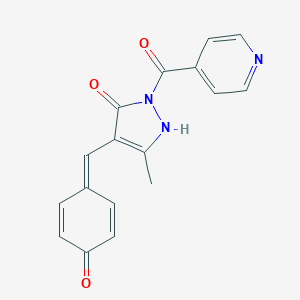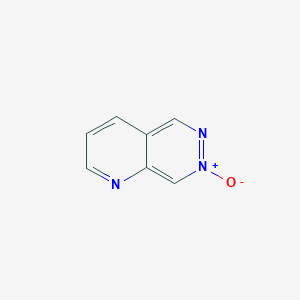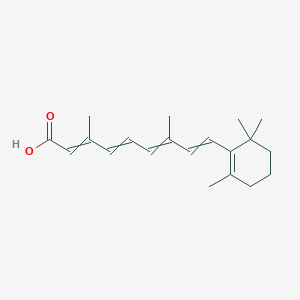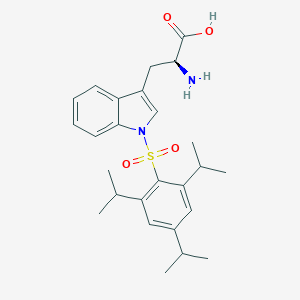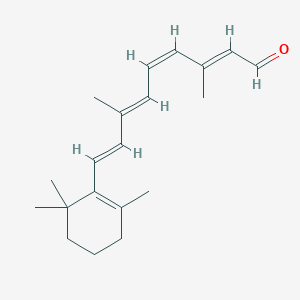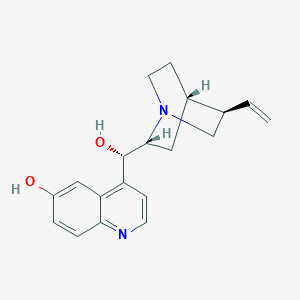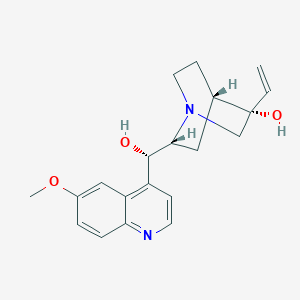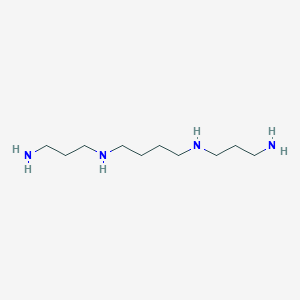
Espermina
Descripción general
Descripción
La espermina es una poliamina natural que participa en el metabolismo celular y se encuentra en todas las células eucariotas. Se deriva del aminoácido ornitina y juega un papel crucial en la estabilización de la estructura helicoidal de los ácidos nucleicos, particularmente en los virus . La this compound también es conocida por su papel como captador de radicales libres intracelulares, protegiendo el ADN del daño oxidativo .
Aplicaciones Científicas De Investigación
La espermina tiene una amplia gama de aplicaciones en la investigación científica:
Mecanismo De Acción
La espermina ejerce sus efectos a través de varios mecanismos:
Captación de Radicales Libres: La this compound actúa como un captador de radicales libres, protegiendo el ADN del daño oxidativo.
Regulación Génica: Participa en la regulación de la expresión génica y la estabilización de la cromatina.
Interacción con Destinos Moleculares: La this compound se une al ADN, previniendo la fragmentación del ADN mediada por endonucleasas y estabilizando la estructura helicoidal.
Análisis Bioquímico
Biochemical Properties
Spermine interacts with various enzymes, proteins, and other biomolecules. The precursor for the synthesis of spermine is the amino acid ornithine . Spermine biosynthesis in animals starts with the decarboxylation of ornithine by the enzyme Ornithine decarboxylase in the presence of PLP . This decarboxylation gives putrescine, which is then converted to spermine .
Cellular Effects
Spermine has been shown to protect cells from a variety of environmental insults . It is associated with nucleic acids and is thought to stabilize helical structure, particularly in viruses . It functions as an intracellular free radical scavenger to protect DNA from free radical attack . Spermine also plays a role in enhancing antioxidant defense mechanisms, glyoxalase systems, methylglyoxal (MG) detoxification, and creating tolerance for drought-induced oxidative stress in plants .
Molecular Mechanism
Spermine exerts its effects at the molecular level through various mechanisms. It functions directly as a free radical scavenger, forming a variety of adducts that prevent oxidative damage to DNA . It also interferes with the binding and stabilization of certain DNA intercalators to DNA .
Temporal Effects in Laboratory Settings
Over time, spermine’s effects can change in laboratory settings. For instance, drought stress increases endogenous spermine in plants, and exogenous application of spermine improves the plants’ ability to tolerate drought stress .
Dosage Effects in Animal Models
The effects of spermine can vary with different dosages in animal models. For example, supplementation of cells with exogenous spermine decreases matrix mineralization in a dose-dependent manner .
Metabolic Pathways
Spermine is involved in several metabolic pathways. In one pathway, L-glutamine is the precursor to L-ornithine, after which the synthesis of spermine from L-ornithine follows the same pathway as in animals . Another pathway in plants starts with decarboxylation of L-arginine to produce agmatine .
Transport and Distribution
Spermine is transported into the mitochondrial matrix by an electrophoretic mechanism having the negative electrical membrane potential (ΔΨ) as the driving force . The presence of phosphate increases spermine uptake by reducing ΔpH and enhancing ΔΨ .
Subcellular Localization
Spermine is primarily found in the nucleus . Subcellular localization studies indicate that spermine is a cytosolic protein undergoing proteasomal control .
Métodos De Preparación
Rutas Sintéticas y Condiciones de Reacción: La espermina se sintetiza a partir de la espermidina a través de la acción de la enzima this compound sintasa. El proceso implica la transferencia de un grupo aminopropilo a la espermidina . Las condiciones de reacción típicamente requieren la presencia de S-adenosil metionina descarboxilada como cofactor .
Métodos de Producción Industrial: La producción industrial de this compound implica la descarboxilación de la ornitina para producir putrescina, que luego se convierte en espermidina. Finalmente, la espermidina se transforma en this compound a través de reacciones de N-alquilación . El proceso está optimizado para la producción a gran escala mediante el control de las condiciones de reacción, como la temperatura, el pH y la concentración de los reactivos .
Análisis De Reacciones Químicas
Tipos de Reacciones: La espermina experimenta varias reacciones químicas, incluyendo oxidación, reducción y sustitución .
Reactivos y Condiciones Comunes:
Reducción: Las reacciones de reducción que involucran this compound son menos comunes, pero pueden ocurrir en condiciones específicas con agentes reductores.
Sustitución: La this compound puede participar en reacciones de sustitución, particularmente en presencia de nucleófilos fuertes.
Productos Principales: Los principales productos formados a partir de estas reacciones incluyen peróxido de hidrógeno, aminoaldehídos y varios derivados sustituidos de this compound .
Comparación Con Compuestos Similares
La espermina forma parte de una familia de poliaminas que incluye espermidina, putrescina y cadaverina .
La this compound es única debido a su mayor número de grupos amino, lo que mejora su capacidad para estabilizar los ácidos nucleicos y proteger contra el daño oxidativo .
Propiedades
IUPAC Name |
N,N'-bis(3-aminopropyl)butane-1,4-diamine | |
|---|---|---|
| Source | PubChem | |
| URL | https://pubchem.ncbi.nlm.nih.gov | |
| Description | Data deposited in or computed by PubChem | |
InChI |
InChI=1S/C10H26N4/c11-5-3-9-13-7-1-2-8-14-10-4-6-12/h13-14H,1-12H2 | |
| Source | PubChem | |
| URL | https://pubchem.ncbi.nlm.nih.gov | |
| Description | Data deposited in or computed by PubChem | |
InChI Key |
PFNFFQXMRSDOHW-UHFFFAOYSA-N | |
| Source | PubChem | |
| URL | https://pubchem.ncbi.nlm.nih.gov | |
| Description | Data deposited in or computed by PubChem | |
Canonical SMILES |
C(CCNCCCN)CNCCCN | |
| Source | PubChem | |
| URL | https://pubchem.ncbi.nlm.nih.gov | |
| Description | Data deposited in or computed by PubChem | |
Molecular Formula |
C10H26N4 | |
| Source | PubChem | |
| URL | https://pubchem.ncbi.nlm.nih.gov | |
| Description | Data deposited in or computed by PubChem | |
Related CAS |
71052-31-8 | |
| Record name | 1,4-Butanediamine, N1,N4-bis(3-aminopropyl)-, homopolymer | |
| Source | CAS Common Chemistry | |
| URL | https://commonchemistry.cas.org/detail?cas_rn=71052-31-8 | |
| Description | CAS Common Chemistry is an open community resource for accessing chemical information. Nearly 500,000 chemical substances from CAS REGISTRY cover areas of community interest, including common and frequently regulated chemicals, and those relevant to high school and undergraduate chemistry classes. This chemical information, curated by our expert scientists, is provided in alignment with our mission as a division of the American Chemical Society. | |
| Explanation | The data from CAS Common Chemistry is provided under a CC-BY-NC 4.0 license, unless otherwise stated. | |
DSSTOX Substance ID |
DTXSID9058781 | |
| Record name | N1,N4-Bis(3-aminopropyl)-1,4-butanediamine | |
| Source | EPA DSSTox | |
| URL | https://comptox.epa.gov/dashboard/DTXSID9058781 | |
| Description | DSSTox provides a high quality public chemistry resource for supporting improved predictive toxicology. | |
Molecular Weight |
202.34 g/mol | |
| Source | PubChem | |
| URL | https://pubchem.ncbi.nlm.nih.gov | |
| Description | Data deposited in or computed by PubChem | |
Physical Description |
Solid; Absorbs carbon dioxide from air; [Merck Index] Colorless solidified mass or fragments; mp = 28-30 deg C; [Sigma-Aldrich MSDS], Solid | |
| Record name | Spermine | |
| Source | Haz-Map, Information on Hazardous Chemicals and Occupational Diseases | |
| URL | https://haz-map.com/Agents/21744 | |
| Description | Haz-Map® is an occupational health database designed for health and safety professionals and for consumers seeking information about the adverse effects of workplace exposures to chemical and biological agents. | |
| Explanation | Copyright (c) 2022 Haz-Map(R). All rights reserved. Unless otherwise indicated, all materials from Haz-Map are copyrighted by Haz-Map(R). No part of these materials, either text or image may be used for any purpose other than for personal use. Therefore, reproduction, modification, storage in a retrieval system or retransmission, in any form or by any means, electronic, mechanical or otherwise, for reasons other than personal use, is strictly prohibited without prior written permission. | |
| Record name | Spermine | |
| Source | Human Metabolome Database (HMDB) | |
| URL | http://www.hmdb.ca/metabolites/HMDB0001256 | |
| Description | The Human Metabolome Database (HMDB) is a freely available electronic database containing detailed information about small molecule metabolites found in the human body. | |
| Explanation | HMDB is offered to the public as a freely available resource. Use and re-distribution of the data, in whole or in part, for commercial purposes requires explicit permission of the authors and explicit acknowledgment of the source material (HMDB) and the original publication (see the HMDB citing page). We ask that users who download significant portions of the database cite the HMDB paper in any resulting publications. | |
Boiling Point |
150-150 °C | |
| Record name | Spermine | |
| Source | DrugBank | |
| URL | https://www.drugbank.ca/drugs/DB00127 | |
| Description | The DrugBank database is a unique bioinformatics and cheminformatics resource that combines detailed drug (i.e. chemical, pharmacological and pharmaceutical) data with comprehensive drug target (i.e. sequence, structure, and pathway) information. | |
| Explanation | Creative Common's Attribution-NonCommercial 4.0 International License (http://creativecommons.org/licenses/by-nc/4.0/legalcode) | |
Solubility |
> 100 mg/mL | |
| Record name | Spermine | |
| Source | DrugBank | |
| URL | https://www.drugbank.ca/drugs/DB00127 | |
| Description | The DrugBank database is a unique bioinformatics and cheminformatics resource that combines detailed drug (i.e. chemical, pharmacological and pharmaceutical) data with comprehensive drug target (i.e. sequence, structure, and pathway) information. | |
| Explanation | Creative Common's Attribution-NonCommercial 4.0 International License (http://creativecommons.org/licenses/by-nc/4.0/legalcode) | |
Mechanism of Action |
Spermine is derived from spermidine by spermine synthase. Spermine is a polyamine, a small organic cations that is absolutely required for eukaryotic cell growth. Spermine, is normally found in millimolar concentrations in the nucleus. Spermine functions directly as a free radical scavenger, and forms a variety of adducts that prevent oxidative damage to DNA. Oxidative damage to DNA by reactive oxygen species is a continual problem that cells must guard against to survive. Hence, spermine is a major natural intracellular compound capable of protecting DNA from free radical attack. Spermine is also implicated in the regulation of gene expression, the stabilization of chromatin, and the prevention of endonuclease-mediated DNA fragmentation. | |
| Record name | Spermine | |
| Source | DrugBank | |
| URL | https://www.drugbank.ca/drugs/DB00127 | |
| Description | The DrugBank database is a unique bioinformatics and cheminformatics resource that combines detailed drug (i.e. chemical, pharmacological and pharmaceutical) data with comprehensive drug target (i.e. sequence, structure, and pathway) information. | |
| Explanation | Creative Common's Attribution-NonCommercial 4.0 International License (http://creativecommons.org/licenses/by-nc/4.0/legalcode) | |
CAS No. |
71-44-3, 68956-56-9 | |
| Record name | Spermine | |
| Source | CAS Common Chemistry | |
| URL | https://commonchemistry.cas.org/detail?cas_rn=71-44-3 | |
| Description | CAS Common Chemistry is an open community resource for accessing chemical information. Nearly 500,000 chemical substances from CAS REGISTRY cover areas of community interest, including common and frequently regulated chemicals, and those relevant to high school and undergraduate chemistry classes. This chemical information, curated by our expert scientists, is provided in alignment with our mission as a division of the American Chemical Society. | |
| Explanation | The data from CAS Common Chemistry is provided under a CC-BY-NC 4.0 license, unless otherwise stated. | |
| Record name | Spermine | |
| Source | ChemIDplus | |
| URL | https://pubchem.ncbi.nlm.nih.gov/substance/?source=chemidplus&sourceid=0000071443 | |
| Description | ChemIDplus is a free, web search system that provides access to the structure and nomenclature authority files used for the identification of chemical substances cited in National Library of Medicine (NLM) databases, including the TOXNET system. | |
| Record name | Hydrocarbons, terpene processing by-products | |
| Source | ChemIDplus | |
| URL | https://pubchem.ncbi.nlm.nih.gov/substance/?source=chemidplus&sourceid=0068956569 | |
| Description | ChemIDplus is a free, web search system that provides access to the structure and nomenclature authority files used for the identification of chemical substances cited in National Library of Medicine (NLM) databases, including the TOXNET system. | |
| Record name | Spermine | |
| Source | DrugBank | |
| URL | https://www.drugbank.ca/drugs/DB00127 | |
| Description | The DrugBank database is a unique bioinformatics and cheminformatics resource that combines detailed drug (i.e. chemical, pharmacological and pharmaceutical) data with comprehensive drug target (i.e. sequence, structure, and pathway) information. | |
| Explanation | Creative Common's Attribution-NonCommercial 4.0 International License (http://creativecommons.org/licenses/by-nc/4.0/legalcode) | |
| Record name | spermine | |
| Source | DTP/NCI | |
| URL | https://dtp.cancer.gov/dtpstandard/servlet/dwindex?searchtype=NSC&outputformat=html&searchlist=268508 | |
| Description | The NCI Development Therapeutics Program (DTP) provides services and resources to the academic and private-sector research communities worldwide to facilitate the discovery and development of new cancer therapeutic agents. | |
| Explanation | Unless otherwise indicated, all text within NCI products is free of copyright and may be reused without our permission. Credit the National Cancer Institute as the source. | |
| Record name | 1,4-Butanediamine, N1,N4-bis(3-aminopropyl)- | |
| Source | EPA Chemicals under the TSCA | |
| URL | https://www.epa.gov/chemicals-under-tsca | |
| Description | EPA Chemicals under the Toxic Substances Control Act (TSCA) collection contains information on chemicals and their regulations under TSCA, including non-confidential content from the TSCA Chemical Substance Inventory and Chemical Data Reporting. | |
| Record name | N1,N4-Bis(3-aminopropyl)-1,4-butanediamine | |
| Source | EPA DSSTox | |
| URL | https://comptox.epa.gov/dashboard/DTXSID9058781 | |
| Description | DSSTox provides a high quality public chemistry resource for supporting improved predictive toxicology. | |
| Record name | 4,9-diazadodecamethylenediamine | |
| Source | European Chemicals Agency (ECHA) | |
| URL | https://echa.europa.eu/substance-information/-/substanceinfo/100.000.686 | |
| Description | The European Chemicals Agency (ECHA) is an agency of the European Union which is the driving force among regulatory authorities in implementing the EU's groundbreaking chemicals legislation for the benefit of human health and the environment as well as for innovation and competitiveness. | |
| Explanation | Use of the information, documents and data from the ECHA website is subject to the terms and conditions of this Legal Notice, and subject to other binding limitations provided for under applicable law, the information, documents and data made available on the ECHA website may be reproduced, distributed and/or used, totally or in part, for non-commercial purposes provided that ECHA is acknowledged as the source: "Source: European Chemicals Agency, http://echa.europa.eu/". Such acknowledgement must be included in each copy of the material. ECHA permits and encourages organisations and individuals to create links to the ECHA website under the following cumulative conditions: Links can only be made to webpages that provide a link to the Legal Notice page. | |
| Record name | SPERMINE | |
| Source | FDA Global Substance Registration System (GSRS) | |
| URL | https://gsrs.ncats.nih.gov/ginas/app/beta/substances/2FZ7Y3VOQX | |
| Description | The FDA Global Substance Registration System (GSRS) enables the efficient and accurate exchange of information on what substances are in regulated products. Instead of relying on names, which vary across regulatory domains, countries, and regions, the GSRS knowledge base makes it possible for substances to be defined by standardized, scientific descriptions. | |
| Explanation | Unless otherwise noted, the contents of the FDA website (www.fda.gov), both text and graphics, are not copyrighted. They are in the public domain and may be republished, reprinted and otherwise used freely by anyone without the need to obtain permission from FDA. Credit to the U.S. Food and Drug Administration as the source is appreciated but not required. | |
| Record name | Spermine | |
| Source | Human Metabolome Database (HMDB) | |
| URL | http://www.hmdb.ca/metabolites/HMDB0001256 | |
| Description | The Human Metabolome Database (HMDB) is a freely available electronic database containing detailed information about small molecule metabolites found in the human body. | |
| Explanation | HMDB is offered to the public as a freely available resource. Use and re-distribution of the data, in whole or in part, for commercial purposes requires explicit permission of the authors and explicit acknowledgment of the source material (HMDB) and the original publication (see the HMDB citing page). We ask that users who download significant portions of the database cite the HMDB paper in any resulting publications. | |
Melting Point |
29 °C | |
| Record name | Spermine | |
| Source | DrugBank | |
| URL | https://www.drugbank.ca/drugs/DB00127 | |
| Description | The DrugBank database is a unique bioinformatics and cheminformatics resource that combines detailed drug (i.e. chemical, pharmacological and pharmaceutical) data with comprehensive drug target (i.e. sequence, structure, and pathway) information. | |
| Explanation | Creative Common's Attribution-NonCommercial 4.0 International License (http://creativecommons.org/licenses/by-nc/4.0/legalcode) | |
| Record name | Spermine | |
| Source | Human Metabolome Database (HMDB) | |
| URL | http://www.hmdb.ca/metabolites/HMDB0001256 | |
| Description | The Human Metabolome Database (HMDB) is a freely available electronic database containing detailed information about small molecule metabolites found in the human body. | |
| Explanation | HMDB is offered to the public as a freely available resource. Use and re-distribution of the data, in whole or in part, for commercial purposes requires explicit permission of the authors and explicit acknowledgment of the source material (HMDB) and the original publication (see the HMDB citing page). We ask that users who download significant portions of the database cite the HMDB paper in any resulting publications. | |
Synthesis routes and methods I
Procedure details








Synthesis routes and methods II
Procedure details





Synthesis routes and methods III
Procedure details





Retrosynthesis Analysis
AI-Powered Synthesis Planning: Our tool employs the Template_relevance Pistachio, Template_relevance Bkms_metabolic, Template_relevance Pistachio_ringbreaker, Template_relevance Reaxys, Template_relevance Reaxys_biocatalysis model, leveraging a vast database of chemical reactions to predict feasible synthetic routes.
One-Step Synthesis Focus: Specifically designed for one-step synthesis, it provides concise and direct routes for your target compounds, streamlining the synthesis process.
Accurate Predictions: Utilizing the extensive PISTACHIO, BKMS_METABOLIC, PISTACHIO_RINGBREAKER, REAXYS, REAXYS_BIOCATALYSIS database, our tool offers high-accuracy predictions, reflecting the latest in chemical research and data.
Strategy Settings
| Precursor scoring | Relevance Heuristic |
|---|---|
| Min. plausibility | 0.01 |
| Model | Template_relevance |
| Template Set | Pistachio/Bkms_metabolic/Pistachio_ringbreaker/Reaxys/Reaxys_biocatalysis |
| Top-N result to add to graph | 6 |
Feasible Synthetic Routes
Descargo de responsabilidad e información sobre productos de investigación in vitro
Tenga en cuenta que todos los artículos e información de productos presentados en BenchChem están destinados únicamente con fines informativos. Los productos disponibles para la compra en BenchChem están diseñados específicamente para estudios in vitro, que se realizan fuera de organismos vivos. Los estudios in vitro, derivados del término latino "in vidrio", involucran experimentos realizados en entornos de laboratorio controlados utilizando células o tejidos. Es importante tener en cuenta que estos productos no se clasifican como medicamentos y no han recibido la aprobación de la FDA para la prevención, tratamiento o cura de ninguna condición médica, dolencia o enfermedad. Debemos enfatizar que cualquier forma de introducción corporal de estos productos en humanos o animales está estrictamente prohibida por ley. Es esencial adherirse a estas pautas para garantizar el cumplimiento de los estándares legales y éticos en la investigación y experimentación.

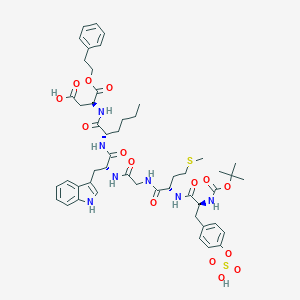
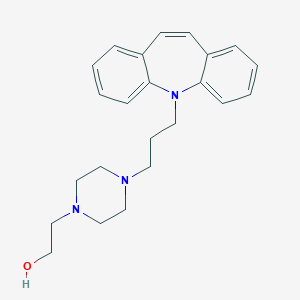
![Ethyl 2-(trifluoromethyl)imidazo[1,2-a]pyridine-3-carboxylate](/img/structure/B22080.png)
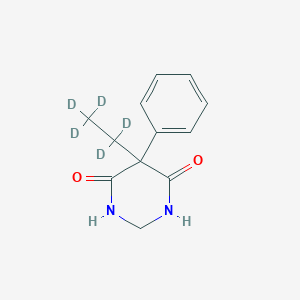
![1-Chloro-2-[(4-chlorophenyl)difluoromethyl]-4-(trifluoromethyl)benzene](/img/structure/B22089.png)

